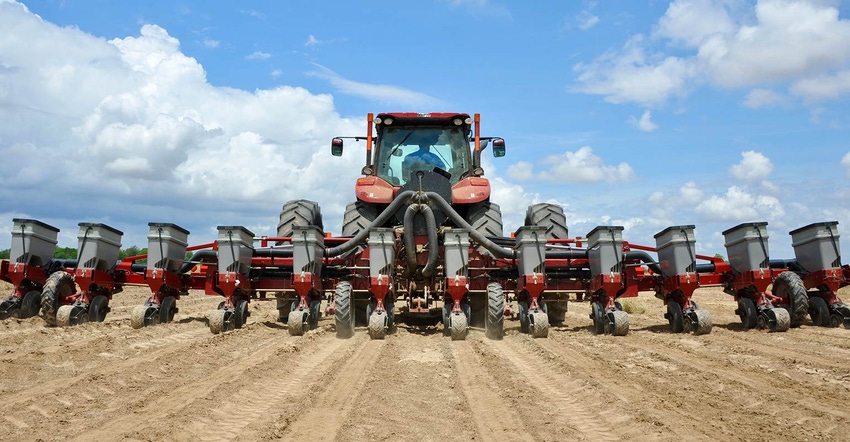June 1, 2020

Sponsored Content
In most years, the early planted soybean production system prevalent in the Mid-South equates to fewer late-season insecticide treatments. 2020 is not most years.
Delayed planting across the Mid-South due to untimely rainfall, poor early season soil conditions and cooler-than-normal soil temperatures mean fewer early planted soybeans and an increased likelihood that the 2020 soybean crop will face the late-summer worm invasion often dodged by more mature crops.
“Typically, our sweet spot for soybean planting is around April 15 in Mississippi. At that time this year, our ground was just too wet and not firm enough to get over it with a planter in most areas,” says Matt McGowin, territory manager for Corteva Agriscience in Flowood, Mississippi.
“In the South Delta, we've got ground that has essentially been under water for a year and a half due to backwater flooding. That's ground that was prevented plant last year and, if it gets planted this year, will be delayed,” he says. "We are definitely going to have a delayed soybean crop in the Mid-South this year.”
Late planting, McGowin says, increases the likelihood of a delayed harvest, putting soybeans green and growing at a time when pest populations are increasing.
“As corn is drying down and being harvested in August, a lot of pests will be emerging from that corn looking for grain foliage to feed on,” McGowin says. “Lush soybeans at that time of year are a prime target for foliage feeders.”
Adding to delayed planting challenges, the Mid-South experienced a mild 2019-2020 winter, enabling some problem pests to successfully overwinter either in the Mid-South or further north than would be expected in a year with colder winter temperatures.
Corn earworm, also known as bollworm, is a midseason pest likely to be present in large numbers this year.
“We are likely going to have insect problems this year and it's probably going to set up a lot like last year from a corn earworm standpoint,” says Jeff Gore, entomologist, Mississippi State University. “Because corn planting was spread out over multiple weeks, there will likely be a long and extended period of bollworm egg lay in soybeans at a time when the crop is vulnerable to feeding damage.”
“If you are putting a fungicide out at the R3 growth stage and you are tank-mixing an insecticide in there to control an assortment of soybean pests, there's still a good chance you are going to have to spray again because of late-season bollworm pressure,” Gore says. “In other words, it's best not to put out a preventive spray with the hope that you won't have to spray again.”
Pulling the trigger on bollworm sprays is dependent upon dynamic thresholds that take into account both the market price for soybeans as well as the price of insecticide treatments.
“With a soybean price of $8.00 per bushel, the dynamic threshold would be 8 to 11 bollworms per 25 sweeps, assuming an average insecticide cost of $15 to $20 per acre,” Gore says.
To control bollworm in soybeans, McGowin generally recommends Intrepid Edge® insecticide at a rate of 5 ounces per acre.
“Our rate range is 4 to 6.4 ounces per acre, but the most common rate we use throughout the Mid-South is 5 ounces per acre,” he says. “That rate provides us with good, quick knockdown and long residual control of bollworm pests.”
“With the two unique modes of action provided by Intrepid Edge, we are getting fast and lasting control, and you are controlling those pests in two different manners - by contact and by ingestion,” he says.
Late planting, combined with a mild 2019-20 winter, means heavy soybean looper pressure also is expected.
“Soybean loopers migrate into the Mid-South every year. However, because soybean looper doesn't have a diapause mechanism, it usually gets cold enough over the winter to kill most of our U.S. populations, delaying threshold-level populations,” Gore says. “Because of the mild winter, they will likely arrive earlier because they were able to survive the winter further north than usual. Even using a product for bollworm with a long residual, soybean growers may need to spray more than once if soybean looper migrates into the region.”
McGowin agrees that soybean looper is one pest that is particularly tough late-season. Fall armyworm is another. “Intrepid Edge is extremely active against both species, providing quick knockdown and good residual from two modes of action,” he says. “When you start seeing feeding on the soybean foliage, it's time to take a closer look when scouting, run some sweeps and determine if you are at threshold level.”
When we talk about planting a late May or June soybean, you are going to experience a plethora of pests near the season's end when your soybeans are the only lush green left standing,” McGowin says.
To learn more about how to protect your soybeans from mid- and late-season pests, visit IntrepidEdge.Corteva.US.
™ ® Trademarks of Dow AgroSciences, DuPont or Pioneer, and their affiliated companies or their respective owners. Intrepid Edge is not registered for sale or use in all states. Contact your state pesticide regulatory agency to determine if a product is registered for sale or use in your state. Always read and follow label directions. © 2020 Corteva. CA14-911-030 (06/20) BR CAAG0INTE054
About the Author(s)
You May Also Like






